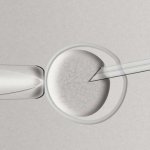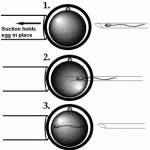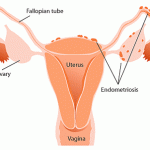Articles Archive for April 2009
Artificial insemination, GIFT procedure »

In patients undergoing the gamete intra-Fallopian transfer (GIFT) procedure, a prospective study was perfonned to establish the predictive value of attempting in-vitro fertilization (IVF) using extra oocytes obtained at laparoscopy and also the value of transferring the resulting embryo(s), in conjunction with GIFT, in the same treatment cyde. The GIFT procedure was performed in 50 treatment cycles involving 43 patients, of whom 20 have achieved clinical pregnancy with an overall success rate of 40% per treatment cycle. In 38 of these patients, one or more extra oocytes were available and …
Artificial insemination, IUI procedure »

Intra-Uterine Insemination (also known as artificial insemination) is the process of preparing and delivering sperm so that a highly concentrated amount of active motile sperm is placed directly through the cervix into the uterus. The current IUI pregnancy rate per treatment at UCSF is 14-15%. IUI can be performed with or without fertility drugs for the female patient. Compared to timed intercourse, it is generally accepted that there is a 2-fold higher pregnancy rate with IUI. Thus, for infertility patients, IUI is commonly performed as a low-tech, cost-effective approach to …
Artificial insemination, Headline, ICSI procedure »

Intracytoplasmic Sperm Injection (ICSI) is performed as part of an IVF procedure to treat male factor abnormalities. After egg retrieval, using a glass needle, a single sperm is selected by and injected into the egg. This often enhances fertilization to help couples conceive when the man has low sperm concentration, motility, or abnormal shapes. The Follas Center of Reproductive Medicine, our adjacent office-based facility, has state-of-the-art equipment to offer this option to our patients undergoing IVF.
Intracytoplasmic sperm injection, or ICSI, is a form of micro-assisted fertilization where the nucleus (genetic …
Artificial insemination, ICSI procedure »

Any IVF (in vitro fertilization) treatment procedure carries risks. ICSI (intra-cytoplasmic sperm injection), being a very delicate and difficult IVF procedure, does carry an even higher risk of failure. Normally during an IVF treatment programme the males sperm are subjected to rigorous procedures to establish their maturity and suitability for the procedure. In an ICSI procedure, because the number of viable sperm available can be so low they are not subjected to a rigorous programme of testing. The risk of an abnormal sperm being injected into the ovum is, therefore, …
Artificial insemination, IVF procedure »

IVF (In Vitro Fertilisation) is an Assisted Reproductive Technology used to help couples conceive. If you have undergone hormonal therapies and artificial insemination without any success in conceiving, then IVF might be for you. To date, IVF is the most popular of all assisted reproductive technologies available.
IVF is the process of creating a fertilised female egg in a laboratory. It involves extracting an egg from the female and sperm from the male, and then placing them together in a lab dish to enhance the chances of fertilisation. If the egg …
PESA procedure »
Percutaneous Epididymal Sperm Aspiration (PESA): A needle is passed through the scrotal skin and into the epididymis in order to aspirate sperm. Because the epididymal tubule is very delicate and convoluted, the yield with a needle is typically small and usually only sufficient for a …
Featured, Infertility causes, Surgical Infertility »

This term denotes anatomic causes of female infertility that lend themselves to surgical repair. With the ascent of IVF (in-vitro fertilization), fewer indications for surgical infertility exist today than a decade ago. Nevertheless, there are still many occasions where competent surgery can make a difference. Examples are myomectomies (the surgical removal of fibroid tumors from the uterus), ovarian cystectomies (the surgical resection of ovarian cysts), tuboplasticies (the surgical correction of abnormal fallopian tubes) and many other procedures.
Surgical Treatment of Infertility
Infertility can be caused by problems in the pelvic anatomy – …
Featured, Ovulatory Dysfunction, Surgical Infertility »

Endometriosis is a medical condition in women in which endometrial cells are deposited in areas outside the uterine cavity. The uterine cavity is lined by endometrial cells, which are under the influence of female hormones. Endometrial cells deposited in areas outside the uterus (endometriosis) continue to be influenced by these hormonal changes and respond similarly as do those cells found inside the uterus. Symptoms often exacerbate in time with the menstrual cycle.
Endometriosis is typically seen during the reproductive years; it has been estimated that it occurs in roughly 5% to …

